
Cambridge is a city in Middlesex County, Massachusetts, in the United States. It is a major suburb in the Greater Boston metropolitan area, located directly across the Charles River from Boston. The city's population as of the 2020 U.S. census was 118,403, making it the largest city in the county, the fourth most populous city in the state, behind Boston, Worcester, and Springfield, and ninth most populous city in New England. It was named in honor of the University of Cambridge in England, which was an important center of the Puritan theology that was embraced by the town's founders.
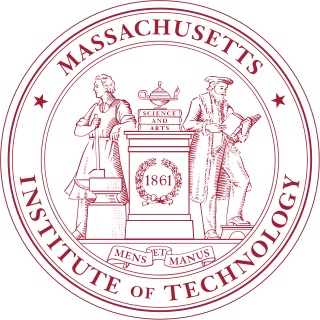
The Massachusetts Institute of Technology (MIT) is a private land-grant research university in Cambridge, Massachusetts. Established in 1861, MIT has played a significant role in the development of many areas of modern technology and science.
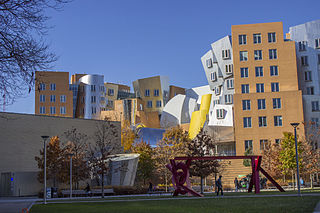
Stata Center, officially the Ray and Maria Stata Center and sometimes referred to as Building 32, is a 430,000-square-foot (40,000 m2) academic complex designed by Pritzker Prize-winning architect Frank Gehry for the Massachusetts Institute of Technology (MIT). The building opened for initial occupancy on March 16, 2004. It is located on the site of MIT's former Building 20, which had housed the historic MIT Radiation Laboratory, at 32 Vassar Street in Cambridge, Massachusetts.

Aesop's Fables, or the Aesopica, is a collection of fables credited to Aesop, a slave and storyteller who lived in ancient Greece between 620 and 564 BCE. Of diverse origins, the stories associated with his name have descended to modern times through a number of sources and continue to be reinterpreted in different verbal registers and in popular as well as artistic media.

The Boy Who Cried Wolf is one of Aesop's Fables, numbered 210 in the Perry Index. From it is derived the English idiom "to cry wolf", defined as "to give a false alarm" in Brewer's Dictionary of Phrase and Fable and glossed by the Oxford English Dictionary as meaning to make false claims, with the result that subsequent true claims are disbelieved.
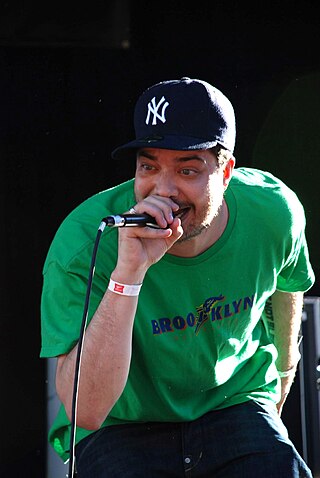
Ian Matthias Bavitz, better known by his stage name Aesop Rock, is an American rapper and producer from Long Island, New York. He was at the forefront of the new wave of underground and alternative hip hop acts that emerged during the late 1990s and early 2000s. He was signed to El-P's Definitive Jux label until it went on hiatus in 2010. In a 2010 retrospective, betterPropaganda ranked him at number 19 at the Top 100 Artists of the Decade.

Joichi "Joi" Ito is a Japanese entrepreneur and venture capitalist. He is the President of Chiba Institute of Technology. He is a former director of the MIT Media Lab, former professor of the practice of media arts and sciences at MIT, and a former visiting professor of practice at the Harvard Law School. Ito has received recognition for his role as an entrepreneur focused on Internet and technology companies and has founded, among other companies, PSINet Japan, Digital Garage, and Infoseek Japan. Ito is a strategic advisor to Sony Corporation and general partner of Neoteny Labs. Ito wrote a monthly column in the Ideas section of Wired.

"The Tortoise and the Hare" is one of Aesop's Fables and is numbered 226 in the Perry Index. The account of a race between unequal partners has attracted conflicting interpretations. The fable itself is a variant of a common folktale theme in which ingenuity and trickery are employed to overcome a stronger opponent.
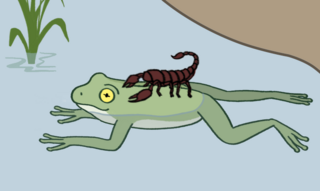
The Scorpion and the Frog is an animal fable which teaches that vicious people cannot resist hurting others even when it is not in their own interests. This fable seems to have emerged in Russia in the early 20th century.

Otto Piene was a German-American artist specializing in kinetic and technology-based art, often working collaboratively. He lived and worked in Düsseldorf, Germany; Cambridge, Massachusetts; and Groton, Massachusetts.
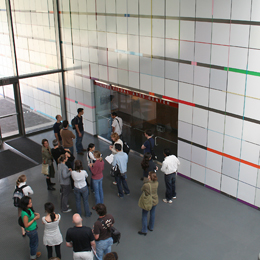
Established in 1950, the List Visual Arts Center (LVAC) is the contemporary art museum of the Massachusetts Institute of Technology. It is known for temporary exhibitions in its galleries located in the MIT Media Lab building, as well as its administration of the permanent art collection distributed throughout the university campus, faculty offices, and student housing.

Aesop was a Greek fabulist and storyteller credited with a number of fables now collectively known as Aesop's Fables. Although his existence remains unclear and no writings by him survive, numerous tales credited to him were gathered across the centuries and in many languages in a storytelling tradition that continues to this day. Many of the tales associated with him are characterized by anthropomorphic animal characters.
Vera G. List was an American art collector and philanthropist. She was awarded a 1996 National Medal of Arts.

The Tortoise and the Hare is a 1994 bronze sculpture by Nancy Schön, installed in Boston's Copley Square, in the U.S. state of Massachusetts. The work references one of Aesop's Fables, The Tortoise and the Hare, and commemorates Boston Marathon participants.

Elmo-MIT is a 1960s bronze sculpture by Dimitri Hadzi, installed on the Massachusetts Institute of Technology campus, in Cambridge, Massachusetts, United States.

Angola is a 1968 Cor-ten steel sculpture by Isaac Witkin, installed on the Massachusetts Institute of Technology (MIT) campus, in Cambridge, Massachusetts, United States.

La Grande Voile (The Big Sail) is a 1965 painted steel sculpture by Alexander Calder, installed in McDermott Court, on the Massachusetts Institute of Technology (MIT) campus, in Cambridge, Massachusetts, United States.

Figure découpée or L'oiseau is an abstract sculpture by Pablo Picasso: there are a total of three Figure découpée sculptures. There is one located in Vondelpark NL, another on the campus of Massachusetts Institute of Technology in the United States and another is in Helsingborg Sweden. The sculpture is a depiction of a bird, but it is commonly referred to as flat bird, flat fish or fish statue.





















